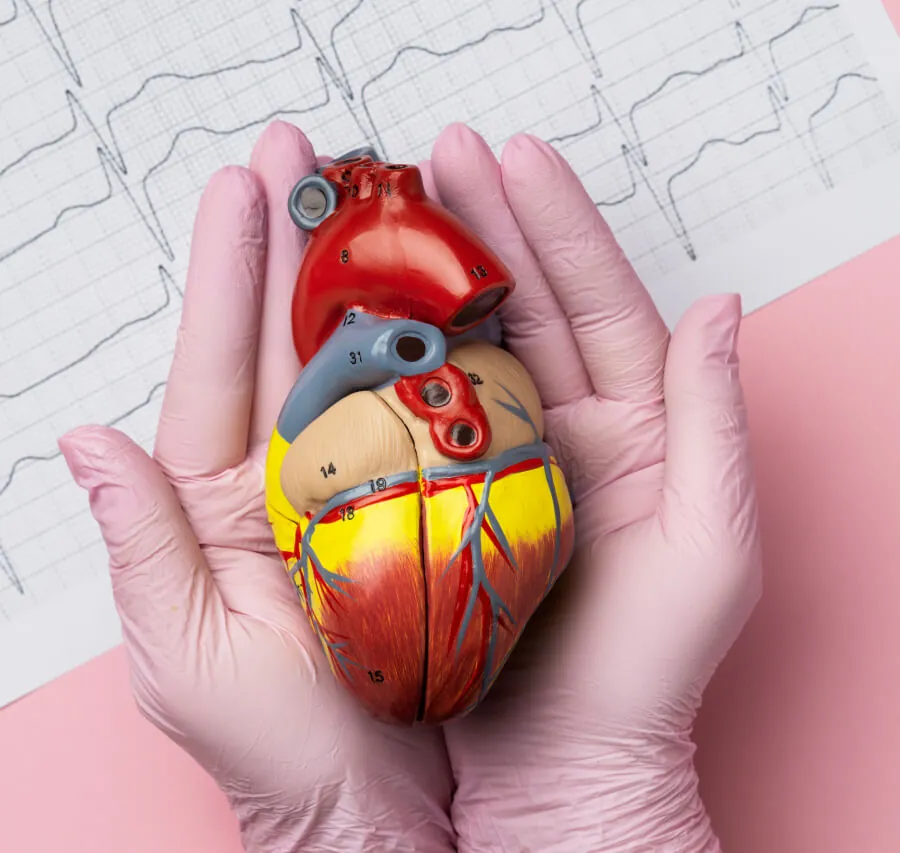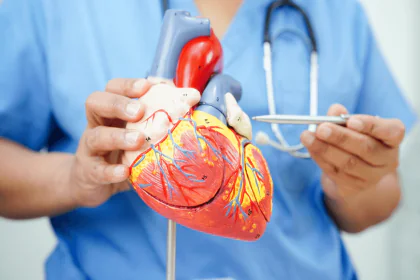Heart valve disease is a condition that affects the valves that regulate the blood flow in the heart.
The heart has four valves: the aortic, the mitral, the pulmonary, and the tricuspid valves.
These valves open and close to allow blood to move in one direction through the heart chambers and to the rest of the body.
However, sometimes the valves can become damaged or diseased, causing them to malfunction.
This can affect the amount and quality of blood that reaches the organs and tissues.
It can lead to serious complications, such as heart failure, stroke, or sudden death.
In this blog post, we will explore the types and common causes of heart valve disease.
And how they can be diagnosed and treated.
We will also share some tips on how to prevent and manage heart valve disease
And improve your heart health and well-being.
Types
There are three main types of heart valve disease, depending on which valve is affected and how it is affected.
These types are:
Stenosis:
This is when the valve opening becomes narrowed or stiffened, preventing it from opening fully.
This reduces the amount of blood that can flow through the valve.
Increases the pressure in the heart chamber behind the valve.
Stenosis can affect any of the four valves, but it is more common in the aortic and mitral valves.
Regurgitation:
This is when the valve does not close properly, allowing blood to leak backward through the valve.
This reduces the amount of blood that is pumped forward to the body.
And causes the heart to work harder to compensate.
Regurgitation can affect any of the four valves, but it is more common in the mitral and tricuspid valves.
Atresia:
This is when the valve is not formed or is completely blocked by a tissue.
This prevents blood from flowing through the valve, and causes a severe lack of oxygen in the body.
Atresia is a rare congenital defect that usually affects the pulmonary valve.
Common Causes of Heart Valve Disease
Heart valve disease can be caused by various factors, such as:
Congenital defects:
Some people are born with abnormal or malformed valves, or with fewer than four valves.
This can affect the structure and function of the valves, and cause problems from birth or later in life.
Congenital defects can affect any of the four valves, but they are more common in the aortic and pulmonary valves.
Age-related changes:
As people get older, the valves can become thickened, calcified, or degenerated, due to:
Wear and tear, inflammation, or infection.
This can affect the flexibility and durability of the valves, and cause them to become stenotic or regurgitant.
Age-related changes can affect any of the four valves, but they are more common in the aortic and mitral valves.
Rheumatic fever:
This is an inflammatory disease that can develop after a strep throat infection.
It can cause damage to the heart valves, especially the mitral and aortic valves, by causing them to:
Become inflamed, scarred, or deformed.
Rheumatic fever can affect people of any age, but it is more common in children and young adults in developing countries.
Infective endocarditis:
This is an infection of the inner lining of the heart, including the valves.
It can be caused by bacteria, fungi, or other microorganisms that enter the bloodstream from:
The mouth, skin, or other parts of the body.
It can damage the valves by causing them to become inflamed, perforated, or covered with clumps of bacteria and blood cells.
Infective endocarditis can affect any of the four valves, but it is more common in the mitral and aortic valves.
Other heart conditions:
Some heart conditions can affect the valves indirectly, by causing changes in the pressure or volume of the blood in the heart chambers.
For example, a heart attack can damage the heart muscle and impair its pumping ability.
Leading to increased pressure in the heart and valve regurgitation.
A heart defect can cause a hole or a shunt between the heart chambers, leading to:
Increased volume in the heart and valve stenosis.
Other heart conditions that can affect the valves include high blood pressure, coronary artery disease, cardiomyopathy, and heart failure.
Diagnosis and Treatment of Heart Valve Disease
Heart valve disease can be diagnosed by various tests and procedures, such as:
Physical examination:
Your doctor will listen to your heart sounds with a stethoscope, and look for signs of valve problems, such as abnormal sounds, murmurs, clicks, or snaps.
Your doctor will also check your pulse, blood pressure, and oxygen level, and look for signs of fluid retention, such as:
Swelling in your ankles, feet, or abdomen.
Echocardiogram:
This is an ultrasound test that uses sound waves to create a picture of your heart and its valves.
It can show the size, shape, and movement of your heart and valves, and measure the blood flow and pressure in your heart chambers and vessels.
It can also detect any valve defects, such as stenosis, regurgitation, or atresia.
Electrocardiogram (ECG):
This is a test that records the electrical activity of your heart.
It can show the rhythm and rate of your heartbeats, and detect any abnormalities, such as:
Arrhythmias, that can be caused by valve problems.
Chest X-ray:
This is a test that uses radiation to create an image of your chest and lungs.
It can show the size and shape of your heart and its valves, and detect any signs of:
Fluid buildup, infection, or enlargement in your heart or lungs.
Cardiac catheterization:
This is a procedure that involves inserting a thin, flexible tube (catheter) into a blood vessel in your:
Groin, arm, or neck, and guiding it to your heart.
It can measure the pressure and oxygen level in your heart chambers and vessels.
Inject a dye that can be seen on an X-ray to show the blood flow and any blockages in your heart and valves.
Magnetic resonance imaging (MRI):
This is a test that uses a strong magnetic field and radio waves to create a detailed image of your heart and its valves.
It can show the structure and function of your heart and valves.
And detect any valve defects, such as stenosis, regurgitation, or atresia.
The treatment of heart valve disease depends on the type and severity of the disease, and the symptoms and complications it causes.
The main goals of treatment are to relieve the symptoms, prevent the disease from getting worse, and reduce the risk of complications.
The treatment options include:
Medications:
These are drugs that can help improve the blood flow and reduce the workload of the heart.
They can also help control the symptoms and complications of heart valve disease, such as:
- Chest pain
- Shortness of breath
- Swelling
- Arrhythmias
- Infections.
Some of the common medications used for heart valve disease are;
- Diuretics
- Beta blockers
- Angiotensin-converting enzyme (ACE) inhibitors
- Angiotensin receptor blockers (ARBs)
- Calcium channel blockers
- Nitrates
- Nticoagulants
- Antiplatelets
Valve repair:
This is a surgery or a minimally invasive procedure that aims to:
Fix the damaged or diseased valve, and restore its normal function.
Valve repair can involve various techniques, such as reshaping, resizing, reinforcing.
Or replacing the valve leaflets, chordae tendineae, or annulus (the ring of tissue that supports the valve).
Valve repair can preserve the natural valve and its advantages, such as durability, compatibility, and lower risk of infection.
However, valve repair is not always possible or effective, depending on the type and extent of the valve damage.
Valve replacement:
This is a surgery or a minimally invasive procedure that involves removing the damaged or diseased valve, and replacing it with an artificial valve.
Valve replacement can provide a durable and effective solution for severe or complex valve problems.
However, valve replacement also has some disadvantages, such as:
- The need for lifelong blood thinners
- The risk of infection or rejection
- The possibility of valve failure or deterioration over time.
There are two main types of artificial valves: Mechanical valves, which are made of metal, plastic, or carbon, and biological valves.
Which are made of animal or human tissue.
Prevention and Management of Heart Valve Disease
Heart valve disease can be prevented or delayed by taking some steps
To protect your heart health and reduce the risk factors for valve problems.
These steps include:
Eating a healthy diet:
You should eat a balanced and varied diet that is low in salt, fat, cholesterol, and sugar
High in fiber, fruits, vegetables, whole grains, lean proteins, and healthy fats.
This can help lower your blood pressure, cholesterol, and blood sugar.
Prevent or manage obesity, diabetes, and other heart conditions that can affect your valves.
Exercising regularly:
You should do at least 150 minutes of moderate-intensity aerobic exercise, such as brisk walking, cycling, or swimming, per week.
You can also do some strength training, such as lifting weights, two or three times per week.
This can help strengthen your heart muscle, improve your blood circulation, lower your blood pressure and cholesterol.
Maintain a healthy weight and body mass index (BMI).
Following your treatment plan:
You should follow your healthcare provider’s instructions on taking your medications, undergoing any procedures or surgeries.
Attend regular checkups and tests.
You should also report any changes in your symptoms or health status to your healthcare provider as soon as possible.
Monitoring your symptoms:
You should keep track of your symptoms, such as:
Chest pain, shortness of breath, fatigue, swelling, or fainting, and how they affect your daily activities and quality of life.
You should also be aware of any signs of infection, such as fever, chills, or redness, and seek medical attention if they occur.
Limiting your salt intake:
You should limit your salt intake to less than 2,000 milligrams per day, or as advised by your healthcare provider.
Too much salt can cause fluid retention, which can worsen your symptoms.
And increase the pressure on your heart and valves.
You should avoid adding salt to your food, and choose low-sodium or sodium-free products when shopping or eating out.
Avoiding tobacco and alcohol:
You should avoid smoking or using any tobacco products.
They can damage your heart and valves, and increase your risk of infection, arrhythmias, and stroke.
You should also limit your alcohol intake to no more than one drink per day for women and two drinks per day for men.
Or as advised by your healthcare provider.
Alcohol can interfere with your medications, increase your blood pressure, and weaken your heart muscle.
Conclusion
Heart valve disease is a serious condition that can affect the quality and quantity of blood that flows through your heart and body.
It can be caused by various factors, such as
Congenital defects, Age-related changes, Rheumatic fever, Infective endocarditis, or other heart conditions.
Depending on which valve is affected and how it is affected, heart valve disease can be classified into three main types:
- Stenosis
- Regurgitation
- Atresia.
Heart valve disease can be diagnosed by various tests and procedures, such as:
Physical examination, echocardiogram, electrocardiogram, chest X-ray, cardiac catheterization, or magnetic resonance imaging.
The treatment of heart valve disease depends on the type and severity of the disease, and the symptoms and complications it causes.
The main goals of treatment are to relieve the symptoms, prevent the disease from getting worse, and reduce the risk of complications.
The treatment options include medications, valve repair, or valve replacement.
Heart valve disease can be prevented or delayed by taking some steps to protect your heart health and reduce the risk factors for valve problems.
These steps include:
- Eating a healthy diet
- Exercising regularly
- Quitting smoking
- Limiting your salt intake
- Maintaining a healthy weight
- Avoiding tobacco and alcohol.
If you have heart valve disease, you should also take some steps to manage your condition and prevent any complications.
These steps include following your treatment plan, monitoring your symptoms, and seeking medical attention if needed.
Heart valve disease is a condition that requires your attention and care.
By understanding the types and causes of heart valve disease, and how to diagnose and treat it.
You can improve your heart health and well-being.
By following the prevention and management tips, you can also reduce the impact of heart valve disease on your life.
Remember, your heart is your most vital organ, and it deserves your love and respect.
FAQs
What is heart valve disease?
Heart valve disease is a condition where one or more of the heart’s valves do not function properly.
The valves may not fully open (stenosis) or close properly (regurgitation), leading to disruptions in blood flow within the heart.
What are the common types of heart valve disease?
Heart valve diseases include aortic stenosis, mitral regurgitation, mitral valve prolapse, aortic regurgitation, and tricuspid regurgitation.
Each type involves specific issues with one or more of the heart’s valves.
What causes heart valve disease?
Heart valve disease can be caused by congenital factors (present at birth) or acquired factors later in life.
Causes include aging, infections, rheumatic fever, heart attacks, and certain medical conditions.
What are the symptoms of heart valve disease?
Symptoms may include:
- Shortness of breath
- Chest pain or discomfort
- Fatigue
- Dizziness or fainting
- Irregular heartbeat
- Swelling in the ankles, feet, or abdomen.
However, some individuals may not experience noticeable symptoms.
How is heart valve disease diagnosed?
Diagnosis involves a combination of medical history review, physical examination.
Also Imaging tests (echocardiogram, MRI, CT scan), and sometimes cardiac catheterization.
These tests help determine the type and severity of the valve disease.
What treatment options are available for heart valve disease?
Treatment options depend on the severity of the condition.
They may include medications to manage symptoms, lifestyle changes.
And in more severe cases, surgical procedures such as valve repair or replacement.
The choice of treatment is personalized based on individual factors.





